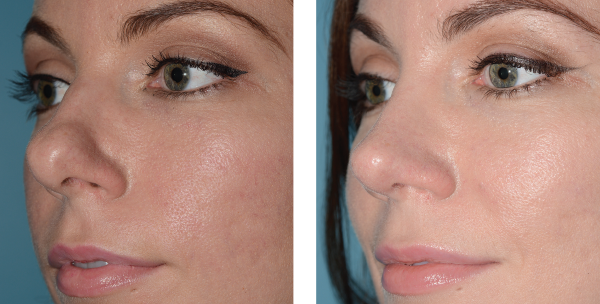
Before (left) and after (right) photos demonstrating functional and cosmetic improvement after lateral crural tensioning.
Photos courtesy Richard Davis, MD
With the septal extension graft, the tip is projected forward but is also buttressed from behind to prevent over-rotation, while also allowing contouring of the silhouette to create the profile contour that the patient wants, Dr. Davis said. You “can put it where you want it, and then you can perfectly position the tip cartilages on this hidden scaffold for the best aesthetic and functional outcome.”
Explore This Issue
April 2019He takes measurements from computer-generated rhinoplasty simulations that are then used to guide placement of the SEG, he said. The repositioning of the lateral crus is then done either with a “lateral crural steal,” in which tension is created when a redundant lateral crus is shortened by laterally repositioning the domal fold, or a “lateral crural lengthening,” in which the lateral crus is elongated to accommodate additional sidewall length by dividing and recruiting the upper medial crus. In both cases, a flat, taut, and attractive side wall with increased resting tone is created to resist inspiratory collapse and eliminate tip bulbosity, he said. “You can tension an over-projected nose, an under-projected nose, or a twisted nose—it doesn’t matter,” he added. “You have to individualize. … It’s not a cookbook and you have to think it through, but it works.”
He acknowledged a common hurdle: patient insistence on a tiny nose. “Keep noses as large as cosmetic tolerances will allow if you want to maintain a satisfactory airway,” he said. “If you’re 10 feet tall, you feel like life is tough at 10 feet, but why would you want me to make you only two feet tall? That’s just a different kind of misery. Somewhere in the middle is happiness, a nose that’s not too big, but also one that’s not too small. That’s where joy lives.”
Thomas Collins is a freelance medical writer based in Florida.
Take-Home Points
- Bulbous nasal tips can bring about not just aesthetic problems, but also functional issues.
- The first principle in the “tensioning” approach is to keep as much natural skeletal tissue as possible, which will mean more strength and stability over time.
- The surgeon must then augment naturally deficient or iatrogenically weak noses with structural grafts that are securely suture-fixated to the existing skeletal components.
- Tensioning the side wall is a way of creating a “taut, flat, and attractive lateral crus” that will increase resistance to inspiratory collapse without the need for sidewall grafts.